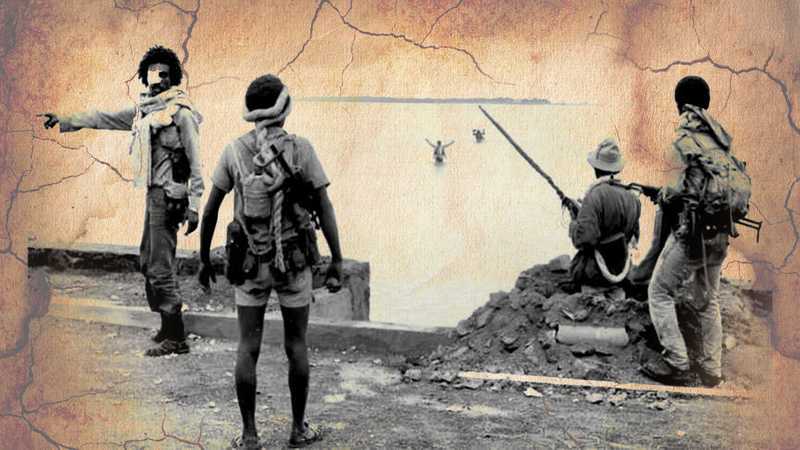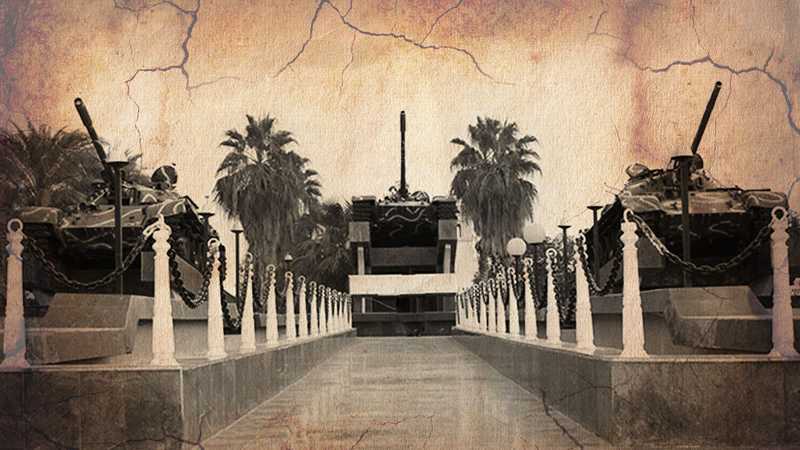The Battle of Massawa - Operation Fenql
8 Feb, 1990 - 11 Feb, 1990
Offensive by Eritrean Peoples Liberation Front forces to liberate Massawa, Eritrea, and cut off the supply route to Asmara, facing the entrenched Ethiopian army and its naval force.
 EPLF fighters look out to sea as Ethiopian soldiers surrender
EPLF fighters look out to sea as Ethiopian soldiers surrender
After the annihilation of the Nadew Command at Afabet, EPLA, the military wing of the EPLF, was at an advantage. Morale was high among the fighters and the army was much better supplied and equipped thanks to the huge cache of weaponry it captured at Afabet, including BM-21 rocket launchers and 130mm field guns.
On February 8, 1990, the EPLF forces began the offensive from the area around She’eb. They named the military campaign “Operation Fenql”, also spelled “Fenkil.” Fenql in Tgrnya can be translated as “to uproot.”
First Phase of the Attack
EPLA launched the attack by rushing to cut off the critical supply route from Asmara, around Gahtelai as the first phase of the attack. To accomplish this, they had to attack and neutralize the Ethiopian garrison at Ad E’le.
A months-long intelligence gathering was undertaken before the attack. The EPLA scouts’ work was so granular that they led two brigades to pass through a narrow gap in the Ethiopian defense line unnoticed by trekking for 18 kilometers to launch a surprise attack behind the enemy lines at 0100 hours in the morning. This was coordinated with other units.
At Ad E’le, EPLA’s attack that was coming from multiple directions created confusion within the Ethiopian army. In the confusion, unaware of the EPLA units that snuck behind them, part of the army was drawn out of the garrison unto the surrounding plains. With the garrison’s defenses in disarray, and with the commander’s added confusion, Ad E’le fell. The attack from the rear was a complete shock to the Ethiopians. The commander was captured in his quarters.
Second Phase of the Attack
In the second phase, the EPLA force split into two directions: one to the Asmara-Massawa road at Dongolo TaHtai while the other veered east toward the port city of Massawa. The plan went relatively smoothly and the road was cut off with units taking control of both sides of the main military artery. The main challenge now was to capture Massawa itself. Many of the commanders at the time undoubtedly would have been careful and diligent not to repeat the failed 1977 Massawa offensive that tried to accomplish the same goal.
Role of EPLF’s Small Naval Force
As part of the overall plan of taking over the port city, the EPLA also used its budding naval force which consisted of mostly small gunboats to attack from the sea, as well as to halt any enemy naval reinforcement that may arrive from Assab to relieve the encircled Ethiopian divisions.
It saw action and faced off with the 45-year-old, well-armed Ethiopian Navy. Leveraging speed and agility, the gunboats sank and destroyed large battleships. This neutralized the effect the firepower the warships could have had in the overall battle scene.
Largest Tank-to-Tank Battle Since World War II
At the same time, the EPLF tank brigades rushed through the northern coastal flatlands in the direction of Massawa. They were met with dogged and tough resistance from the Ethiopian tanker units in the northwest vicinity of the resort beach of Gurgusum, around Desiet. Up to that time, this is believed to be the largest tank-to-tank combat in Africa since the desert tank battles of World War II in North Africa in 1942 with Ethiopia’s 150 tanks facing off with EPLA’s 40.
Although some tanks were lost due to enemy fire, mines and mechanical issues, the tank units were able to push through and arrive at the Salina salt ponds and E’daga suburbs of Massawa. The Salina units faced Grar where the entrenched Ethiopian naval base was located while those at E’daga, the suburb connected to the peninsula of Massawa by a causeway, faced the interior of Massawa. Having destroyed many enemy divisions while taking thousands as POWs, the infantry units also arrived from the west. The E’daga units regrouped at the mouth of the 1-kilometer-long causeway, Sgalet QeTan, that connected interior Massawa, Twalet, to the mainland.
 Sgalet QeTan causeway leading into Twalet, the interior of the port City of Massawa
Sgalet QeTan causeway leading into Twalet, the interior of the port City of Massawa
The Challenge of Sgalet QeTan
Attacking the enemy by crossing the defenseless causeway was an extremely dangerous undertaking as there was no cover once the units were on the causeway, with the open sea on both sides and no protective railing of any sort.
Costly Mistakes
In the fog of war, costly confusions occurred. In the darkness of the night, one of the tanks that had arrived late was rushing to join its unit. Unbeknownst to them, their tank company had decided to regroup outside Cinema Aida at E’daga, several meters off of the mouth of the causeway.
At full speed, the tankers went straight onto the causeway to the shock of their comrades. Per normal agreed-upon protocol during attacks, they had turned off their radio; the desperate calls of their commanders could not reach them. They were only thinking they were running late. They made it to the peninsula but died heroically fighting to the bitter end.
Rushing Sgalet QeTan
After much discussion, the causeway being the only way to enter the peninsula, it was decided to go for a frontal attack during the day with infantry accompanying the tanks. However, this plan failed. Many fell on the way while many others were pinned on both sides of the causeway. The tankers however went on at speed while firing. There was no turning back, nor was that an option being so exposed.
The Ethiopian army, expecting this attack, had strengthened its defenses by repurposing shipments of grain from the port to be used as sandbags. They set up anti-tank canon guns on the other end. They were firing at will. At half way, one of the tanks was hit and started burning. The fighters from the burning tank jumped out and fought with their assault guns. Two of them fell while the rest jumped into the sea and managed to join their units after an arduous slog.
 EPLF infantry units rushing Sgalet QeTan causeway under direct enemy fire at the Battle of Massawa
EPLF infantry units rushing Sgalet QeTan causeway under direct enemy fire at the Battle of Massawa
The other tank, named Commander No. 1, rushed and rammed into two armored vehicles, one of them carrying a ZU-23 anti-aircraft gun destroying it. Commander was hit and the vehicles burned together and all the EPLF fighters inside. The other two tanks that made it to the peninsula were named Jaguar and Tiger.
 EPLF tank, named Commander No. 1, rammed into the vehicle carrying a ZU-23 anti-aircraft gun in a final death match at the Battle of Massawa
EPLF tank, named Commander No. 1, rammed into the vehicle carrying a ZU-23 anti-aircraft gun in a final death match at the Battle of Massawa
Four such attacks were launched on the 11th with all attempts not being able to dislodge the Ethiopian army. One infantry battalion lost 60 fighters in the attempt while 13 tankers died.
Taking on the Naval Base
The combined infantry and mechanized units at Grar launched the attack to take the naval base from the area around St. Michael’s Church. The role of the artillery and the heavy covering fire was crucial in this attack. A similar attempt in 1977 had cost the EPLF so many lives ending up in a full retreat.
Fighters used the covering fire, the terrain and manmade canals to get close to the base and storm it. They faced fierce resistance inside the naval base in a building-by-building combat. However, their morale was high and victory had felt so close this time. They fought on and were able to take full control of the base.
Changing the Plan of Attack
The brave and yet costly plan to take the interior via Sgalet Qetan did not work in the end and the EPLF military commanders had to think of a new plan. While acknowledging the risk, as reinforcement, they brought some of the infantry brigades that were posted further inland at the Asmara-Massawa road. These units were posted there to block any enemy advance coming from Asmara per phase 1 of the attack.
They also pulled some of the navy boats from their missions at sea to stealthily transport infantry units through open water into the harbor located inside the peninsula of Massawa. All artillery and mechanized units on the mainland were ordered to unleash all firepower onto the peninsula, pinning down and neutralizing Ethiopian army’s defenses. The heavy covering bombardment and the diversional fire were instrumental as the landings were successful with no major incident reported to their surprise.
Once the landings were done, infantry units were ready to engage the Ethiopian army in Twalet, the city center in the peninsula of Massawa.
The Twalet Hostage Situation
In Twalet, one Ethiopian officer commanding about a thousand troops took the whole community hostage and would not negotiate. He wanted to hold until reinforcements came through the sea or air. Messages written by his former commanding officers, who were now POWs, were delivered to him saying that all was lost and no relief was coming. It was a “challenging situation” as Sibhat Efrem, EPLF commander, would describe it.
Massawa Liberated
EPLA forces waited for 3 days with a ceasefire but couldn’t wait any longer. They proceeded to attack. Soon, they took control of the entire port city.
As a military strategy, the capture of the naval base on the 11th marked the end of the campaign. But the hostage situation in Twalet dragged on until the 16th. That’s when the entire city came under full control and Sgalet QeTan was finally secured.
Formation of the New Ghinda Front
After this defeat, the remainder of the Ethiopian forces retreated to Ghinda, further up the Asmara-Massawa road where a long chain of trenches would form the most challenging front yet, the Ghinda Front.
The loss of Massawa was a bitter pill to swallow for the Ethiopian government. Their air force continued to carry out sorties of indiscriminate aerial bombardment of the city and its civilian population. These bombardments included the banned napalm and cluster bombs that caused horrific casualties. For Eritreans, this Massacre at Massawa would come to be defiantly known as “qbtset”, loosely translated as the “desperate realization”, referring to the enemy’s undeniable defeat.
 The Tank Memorial at Twalet, Massawa, commemorates the heroes of the three tanks: Commander No. 1, Jaguar and Tiger
The Tank Memorial at Twalet, Massawa, commemorates the heroes of the three tanks: Commander No. 1, Jaguar and Tiger
